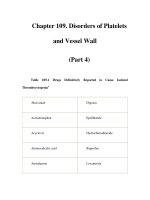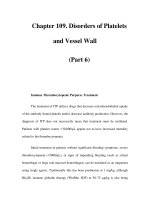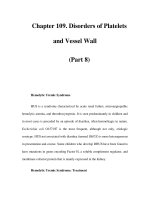Textbook of Neuroanaesthesia and Critical Care - part 1 potx
Bạn đang xem bản rút gọn của tài liệu. Xem và tải ngay bản đầy đủ của tài liệu tại đây (1.39 MB, 52 trang )
Pa
g
e i
Textbook of Neuroanaesthesia and Critical Care
Pa
g
e ii
DEDICATION
To our patients
Pa
g
e iii
Textbook of Neuroanaesthesia and Critical Care
Edited by
Basil F Matta MB BCh BA BOA DA FRCA
Consultant in Anaesthesia and Neuro-Critical Care
Director of Neuroanaesthetic Services
Addenbrookes Hospital
University of Cambridge
U
K
David K Menon PhD MD MBBS FRCP FRCA FmedSci
Lecturer in Anaesthesia
University of Cambridge
Director of Neurocritical Care
Addenbrookes Hospital
University of Cambridge
U
K
John M Turner MBBS FRCA
Consultant in Anaesthesia and Neuro-intensive Care
Addenbrookes Hospital
Associate Lecturer
University of Cambridge
U
K
Pa
g
e iv
© 2000
GREENWICH MEDICAL MEDIA LTD
137 Euston Road
London
N
W1 2AA
ISBN 1 900151 73 1
First Published 2000
Apart from any fair dealing for the purposes of research or private study, or criticism or review, as permitted under the UK Copyright
Designs and Patents Act 1988, this publication may not be reproduced, stored, or transmitted, in any form or by any means, without
the prior permission in writing of the publishers, or in the case of reprographic reproduction only in accordance with the terms of the
licences issued by the appropriate Reproduction Rights Organisations outside the UK. Enquiries concerning reproduction outside the
terms stated here should be sent to the publishers at the London address printed above.
The right of Basil F Matta, David K Menon and John M Turner to be identified as editors of this work has been asserted by them in
accordance with the Copyright Designs and Patents Acts 1988.
The publisher makes no representation, express or implied, with regard to the accuracy of the information contained in this book and
cannot accept any legal responsibility or liability for any errors or omissions that may be made.
A catalogue record for this book is available from the British Library.
Typeset by Saxon Graphics Ltd, Derby
Printed in Spain by Grafos
Pa
g
e v
CONTENTS
Table of Contents
5
Contributors
8
Section 1
Neuro
p
h
y
siolo
gy
and Neuro
p
harmacolo
gy
Robert Macfarlane
1
Anatomical Considerations in Neuroanaesthesia
3
David K Menon
2
The Cerebral Circulation
17
Patrick W Doyle, Arun K Gupta
3
Mechanisms of Injury and Cerebral Protection
35
John M Turner
4
Intracranial Pressure
51
Section 2
Monitorin
g
the CNS
Brian McNamara, Simon J Boniface
5
Electrophysiological Monitoring of the Central Nervous System
67
Sarah Walsh, Basil F Matta
6
Bedside Measurements of Cerebral Blood Flow
87
Marek Czosnycka
7
Monitoring Intracranial Pressure
99
Mayesh Prabhu, Basil F Matta
8
Transcranial Doppler Ultrasonography
113
Arun K Gupta, Basil F Matta
9
Cerebral Oximetry
131
Peter J A Hutchinson, Mark T O'Connell
10
Monitoring Brain Chemistry
147
Pawanjit S Minhas, Peter J Kirkpatrick
11
Multimodal Monitoring in Neurointensive Care
157
Pa
g
e vi
Section 3
Intrao
p
erative Mana
g
ement of Neurosur
g
ical Patients
John M Turner
12
Some General Considerations in Neuroanaesthesia
171
John M Turner
13
Anaesthesia for Surgery of Supratentorial Space-Occupying Lesions
181
Leisha S Godsiff, Basil F Matta
14
Anaesthesia for Intracranial Vascular Surgery
191
Sanjeeva Gupta, Basil F Matta
15
Anaesthesia for Carotid Surgery
209
Fay Gilder, John M Turner
16
Principles of Paediatric Neurosurgery
227
Karen J Heath, Richard E Erskine
17
The Anaesthetic Management of Spinal Injuries and Surgery to the Cervical Spine
239
Andrew C Summors, Richard E Erskine
18
Anaesthesia for Neurosurgery Without Craniotomy
253
Catherine Duffy
19
Anaesthesia for Posterior Fossa Surgery
267
Section 4
Neurosur
g
ical and Neurolo
g
ical Intensive Care
Mark J Abrahams, David K Menon, Basil F Matta
20
Management of Acute Head Injury: Pathophysiology, Initial Resuscitation and
Transfe
r
283
David K Menon, Basil F Matta
21
Intensive Care after Acute Head Injury
299
Robert L Ross-Russell
22
ICU of Paediatric Head Injury
319
Leisha S Godsiff, Basil F Matta
23
Intensive Care Management of Intracranial Haemorrhage
329
Helen L Smith
24
Postoperative Care in the Neurointensive Care Uni
t
343
Liz A Warburton
25
Management of Acute Ischaemic Stroke
353
Alasdair J Coles
26
N
euromuscular Disease in the Neurological Intensive Care Unit
369
Richard Seigne, Kevin E J Gunning
27
Brainstem Death and Management of the Organ Dono
r
381
Pa
g
e vii
Section 5
Anaesthesia for Neuroima
g
in
g
John M Turner
28
Anaesthesia for Neuroradiology
399
Rowan M Burnstein, David K Menon
29
Anaesthesia for Magnetic Resonance Imaging
411
Index
427
Pa
g
e ix
CONTRIBUTORS
Mark J Abrahams
MBBS
Specialist Registrar in Anaesthesia
A
ddenbrookes Hospital
Cambridge, U
K
Simon J Boniface
MD MA BSc MRCP
Consultant in Neurophysiology
Department of Clinical Neurophysiology
A
ddenbrookes Hospital
Cambridge, UK
Rowan M Burnstein
FRCA
Research Fellow
M
RC Brain Repair Centre
Cambridge, UK
Alasdair J Coles
MRCP PhD
Specialist Registrar in Neurology
A
ddenbrookes Hospital
Cambridge, UK
Marek Czosnyka
PhD
Lecturer in Neurophysics
A
cademic Neurosurgical Uni
t
A
ddenbrookes Hospital
Cambridge, UK
Patrick W Doyle
MBBS FRCA
Specialist Registrar in Anaesthesia
A
ddenbrookes Hospital
Cambridge, UK
Catherine Duffy
MD FRCP(C)
Clinical Fellow in Neuroanaesthesia
A
ddenbrookes Hospital
Cambridge, UK
Richard E Erskine
MBBS FRCA
Consultant in Anaesthesia
A
ddenbrookes Hospital
Cambridge, UK
Fay Gilder
FRCA
Specialist Registrar
D
epartment of Anaesthesia
A
ddenbrookes Hospital
Cambridge, UK
Leisha S Godsiff
MBBS FRCA
Specialist Regsitrar in Anaesthesia
A
ddenbrookes Hospital
Cambridge, UK
Kevin E J Gunning
FRCA
Consultant in Intensive Care and Anaesthesia
D
epartment of Anaesthesia
A
ddenbrookes Hospital
Cambridge, UK
Arun Gupta
MBBS FRCA
Consultant in Anaesthesia and Neuro-Intensive Care
A
ddenbrookes Hospital
Cambridge, UK
Pa
g
e x
Sanjeeva Gupta
MBBS FRCA
Specialist Registrar in Anaesthesia
A
ddenbrookes Hospital
Cambridge, UK
Karen J Heath
MBBS FRCA
Specialist Registrar in Anaesthesia
A
ddenbrookes Hospital
Cambridge, UK
Peter J A Hutchinson
MBBS FRCS
Specialist Registrar in Anaesthesia
A
ddenbrookes Hospital
Cambridge, UK
Peter J Kirkpatrick
FRCS
Consultant Neurosurgeon
A
cademic Department of Neurosurgery
A
ddenbrookes Hospital
Cambridge, UK
Robert Macfarlane
MD, FRCS
Consultant Neurosurgeon
D
epartment of Neurosurgery
A
ddenbrookes Hospital
Cambridge, UK
Brian McNamara
MD BSc MRCP(Irl)
Registrar in Neurophysiology
D
epartment of Clinical Neurophysiology
A
ddenbrookes Hospital
Cambridge, UK
Basil F Matta
MB BCh BA BOA DA FRCA
Consultant in Anaesthesia and Neuro-Critical Care
Director of Neuroanaesthetic Services
A
ddenbrookes Hospital
Cambridge, UK
David Menon
PhD MD MBBS FRCP FRCA FmedSci
Lecturer in Anaesthesia
University of Cambridge
Director of Neurocritical Care
A
ddenbrookes Hospital
Cambridge, UK
Pawanjit S Minhas
FRCA
Specialist Registrar in Neurosurgery
University Department of Neurosurgery
A
ddenbrookes Hospital
Cambridge, UK
Mark T O'Connell
PhD
Senior Research Associate
M
RC Brain Repair Centre
Cambridge, UK
Ma
y
esh Prabhu
MBBS
Specialist Registrar in Anaesthesia
A
ddenbrookes Hospital
Cambridge, U
K
Robert L Ross-Russell
MB BCh MRCP
Director of Paediatric Intensive Care
A
ddenbrookes Hospital
Cambridge, UK
Richard Seinge
FRCA
Specialist Registrar in Anaesthesia
D
epartment of Anaesthesia
A
ddenbrookes Hospital
Cambridge, UK
Helen L Smith
MB BS FRCA
Specialist Registrar in Anaesthesia
D
epartment of Anaesthesia
A
ddenbrookes Hospital
Cambridge, UK
Andrew C Summors
MBBS FRCA
Specialist Registrar in Anaesthesia
A
ddenbrookes Hospital
Cambridge, UK
John M Turner
MBBS FRCA
Consultant in Anaesthesia and Neuro-Intensive Care
A
ddenbrookes Hospital
Associate Lecturer
University of Cambridge
Pa
g
e xi
Sarah Walsh
MBBS FRCA
Specialist Registrar in Anaesthesia
A
ddenbrookes Hospital
Cambridge, UK
Liz A Warburton
MA DM MRCP
Consultant Physician
A
ddenbrookes Hospital
Cambridge, UK
Pa
g
e xiii
PREFACE
N
euroanaesthesia, perhaps more than any other field of anaesthesia has represented an area where the expertise and competence of
the anaesthetist can influence patient outcome. Indeed, developments in neurosurgery, neurointensive care and neuroradiology have
only been possible due to concomitant advances in neuroanaesthesia. These advances in clinical practice have always been
underpinned by experimental research, and there has also been a tradition of high quality clinical research in our specialty. The
development continues, and the availability of novel drugs and monitoring modalites represent both an opportunity and a challenge.
They represent an opportunity because the use of modern imaging, novel monitoring modalities and multimodality integration of
such data provide exciting insights into disease mechanisms and pathophysiology, and allow the specific selection of appropriate
therapies. They also represent a challenge because there is a danger that we may confuse the aim of improved clinical management
with the technological means of achieving it.
We hope therefore, that this book will provide not only an understanding of the science that underpins modern clinical practice in
neuroanaesthesia and neurointensive care, but also the clinical context in which such concepts are best applied. Wherever possible,
we have attempted to base our recommendations on high quality clinical research with outcome evaluation. Where paucity of such
data or rapid advances in the understanding of disease makes this inappropriate, we have based our management on personal
experience and data regarding clinical pathophysiology. While we expect that future studies addressing clinical pathophysiology and
outcome will modify practice, this book is a distillation of current knowledge, experience and prejudices, as viewed from Cambridge.
BASIL F MATTA
DAVID K MENON
JOHN M TURNER
OCTOBER, 1999
Pa
g
e xv
ACKNOWLEDGEMENTS
We would like to thank all our anaesthetic, neurosurgical and nursing colleagues for their help and encouragement during the
p
reparation of this book.
Pa
g
e 1
SECTION 1—
NEUROPHYSIOLOGY AND NEUROPHARMACOLOGY
Pa
g
e 3
1—
Anatomical Considerations in Nuroanaesthesia
Robert Macfarlane
Introduction 5
The Cranium 5
The Spine 14
References 16
Pa
g
e 5
Introduction
There are a multitude of anatomical details which influence the way in which neurosurgeons approach specific problems and which
are likely to impinge upon anaesthesia. This chapter provides an overview of some of the more important ones, but without
b
urdening the reader with excessive detail that can be found in standard anatomical texts.
The Cranium
A
natomy of the CSF Pathways
The lateral ventricles are C-shaped cavities within the cerebral hemispheres. Each drains separately into the third ventricle via the
foramen of Monro, which is situated just in front of the anterior pole of the thalamus. The third ventricle is a midline slit, bounded
laterally by the thalami and inferiorly by the hypothalamus. It drains via the narrow aqueduct of Sylvius through the dorsal aspect of
the midbrain to open out into the diamond-shaped fourth ventricle. This has the cerebellum as its roof and the dorsal aspect of the
pons and medulla as its floor. The fourth ventricle opens into the basal cisterns via a midline foramen of Magendie, which sits
p
osteriorly between the cerebellar tonsils, and laterally into the cerebellopontine angle via the foraminae of Luschka.
Approximatley 80% of the cerebrospinal fluid (CSF) is produced by the choroid plexus in the lateral, third and fourth ventricles. The
remainder is formed around the cerebral vessels and from the ependymal lining of the ventricular system. The rate of CSF production
(500–600ml per day in the adult) is independent of intraventricular pressure, until intracranial pressure (ICP) is elevated to the point
at which cerebral blood flow (CBF) is compromised. Absorption, however, is largely by bulk flow and is therefore pressure-related.
Most of the CSF is reabsorbed via the arachnoid villi into the superior sagittal sinus, while some is reabsorbed in the lumbar theca.
CSF flow across the ventricular wall into the brain extracellular space is not an important mechanism under physiological conditions.
H
y
droce
p
halus
Obstruction to CSF flow results in hydrocephalus. This is divided clinically into communicating and non-communicating types
(otherwise known as obstructive/non-obstructive), depending upon whether the ventricular system communicates with the
subarachnoid space in the basal cisterns. The distinction between the two is important when considering treatment (see below).
Examples of communicating hydrocephalus include subarachnoid haemorrhage (either traumatic or spontaneous, both of which silt
up the arachnoid villi), meningitis and sagittal sinus thrombosis. In contrast, aqueduct stenosis, intraventricular haemorrhage and
intrinsic tumours are common causes of non-communicating hydrocephalus.
The diagnosis is usually made by the appearance on CT or MRI scan. The features which suggest active hydrocephalus rather than ex
vacuo dilatation of the ventricular system secondary to brain atrophy are:
• dilatation of the temporal horns of the lateral ventricles (> 2mm width);
• rounding of the third ventricle or ballooning of the frontal horns of the lateral ventricles;
• low density surrounding the frontal horns of the ventricles. This is caused by transependymal flow of CSF and is known as
p
eriventricular lucency (PVL). However, in the elderly this sign may be misleading as it is also seen after multiple cerebral infarcts.
M
anagement of Hydrocephalus
If the hydrocephalus is communicating then CSF can be drained from either the lateral ventricles or the lumbar theca. Generally, this
will involve the insertion of a permanent indwelling shunt unless the cause for the hydrocephalus is likely to be transient, infection is
present or blood within the CSF is likely to block the shunt. Under such circumstances, either an external ventricular or lumbar drain
or serial lumbar punctures may be appropriate.
Obstructive hydrocephalus requires CSF drainage from the ventricular system. Lumbar puncture is potentially dangerous because of
the risk of coning if a pressure differential is created between the cranial and spinal compartments. A single drainage catheter is
adequate if the lateral ventricles communicate with each other (the majority of cases) but bilateral catheters are needed if the
b
lockage lies at the foramen of Monro.
Many forms of non-communicating hydrocephalus can now be treated by endoscopic third ventriculostomy, obviating the need for a
prosthetic shunt. An artificial outlet for CSF is created in the floor of the third ventricle between the mamillary bodies and the
infundibulum, via an endoscope introduced through the frontal horn of the lateral ventricle and foramen of Monro. This allows CSF
to drain directly from the third ventricle into the basal cisterns, where it emerges between the posterior clinoid processes and the
b
asilar artery.
Pa
g
e 6
B
rain Structure and Function
Disorders of different lobes of the brain produce characteristic clinical syndromes, dependent not only on site but also side. Almost
all right-handed patients (93%–99%) are left hemisphere dominant, as are the majority of left-handers and those who are
ambidextrous (ranging from 50% to 92% in various studies; for review, see
1
).
Intracranial mass lesions generally present in one of three ways: focal neurological deficit, symptoms or signs of raised intracranial
pressure, or with epilepsy. A very simple guide to the neurological deficits which may develop in association with disorders of the
cerebral or cerebellar hemispheres is as follows.
The Frontal Lobe
The frontal lobe is the hemisphere anterior to the Rolandic fissure (central sulcus; Fig. 1.1). Important areas within it are the motor
strip, Broca's speech area (in the dominant hemisphere) and the frontal eye fields. Patients with bilateral frontal lobe dysfunction
typically present with personality disorders, dementia, apathy and disinhibition. The anterior 7 cm of one frontal lobe can be resected
without significant neurological sequelae, providing that the contralateral hemisphere is normal. Resections more posterior than this
in the dominant hemisphere are likely to damage the anterior speech area.
Tem
p
oral Lobe
The temporal lobe lies anteriorly below the Sylvian fissure and becomes the parietal lobe posteriorly at the angular gyrus (Fig. 1.1).
The uncus forms its medial border and is of particular clinical importance because it overhangs the tentorial hiatus adjacent to the
midbrain. When intracranial pressure rises in the supratentorial compartment, it is the uncus of the temporal lobe which transgresses
the tentorial hiatus, compressing the third nerve, midbrain and posterior cerebral artery.
Figure 1.1
Topography of the brain. A = Angular gyrus;
C = Central sulcus (Rolandic fissure);
PC
= Pre-central sulcus; S = S
y
lvian fissure.
There are many functions to the temporal lobe including memory, the cortical representation of olfactory, auditory and vestibular
information, some aspects of emotion and behaviour, Wernicke's speech area (in the dominant hemisphere) and parts of the visual
field pathway.
Like the frontal lobe, lesions in the temporal lobe may present with memory impairment or personality change. Seizures are common,
with prodromal symptoms linked typically to the function of the temporal lobe (e.g. olfactory, auditory or visual hallucinations,
unpleasant visceral sensations, bizarre behaviour or
d
éjà vu).
The anterior 5–6 cm of one temporal lobe (approximately at the junction of the Rolandic and Sylvian fissures) may be resected.
Usually the upper part of the superior temporal gyrus is preserved to protect the branches of the middle cerebral artery lying in the
Sylvian fissure. More posterior resection may damage the speech area in the dominant hemisphere. Care is needed if resecting the
medial aspect of the uncus because of proximity to the optic tract. In some patients undergoing temporal lobectomy (the majority of
epilepsy cases, for example), it may be appropriate to undertake a sodium amytal test preoperatively, to both confirm laterality of
language and establish whether the patient is likely to suffer significant memory impairment as a result of the procedure. This
investigation, otherwise known as the Wada test, involves selective catheterization of each internal carotid artery in turn. Whilst the
hemisphere in question is anaesthetized with sodium amytal (effectiveness is confirmed by the onset of contralateral hemiplegia), the
patient's ability to speak is evaluated. They are then presented with a series of words and images which they are asked to recall once
the hemiparesis has recovered, thereby assessing the strength of verbal and non-verbal memory in the contralateral hemisphere.
Parietal Lobes
These extend from the Rolandic fissure to the parietooccipital sulcus posteriorly and to the temporal lobe inferiorly. The dominant
hemisphere shares speech function with the adjacent temporal lobe, while both sides contain the sensory cortex and visual association
areas.
Pa
g
e 7
Parietal lobe dysfunction may produce cortical sensory loss or sensory inattention. In the dominant hemisphere the result is
dysphasia and in the non-dominant, dyspraxia (e.g. difficulty dressing, using a knife and fork or difficulty with spatial
orientation). Involvement of the visual association areas may give rise to visual agnosia (inability to recognize objects) or to
alexia (inability to read).
Occi
p
ital Lobes
Lesions within the occipital lobe typically present with a homonymous field defect which does not spare the macula. Visual
hallucinations (flashes of light, rather than the formed images which are typical of temporal lobe epilepsy) may develop.
Resection of the occipital lobe will result in a contralateral homonymous hemianopia. The extent of resection is restricted to
3.5cm from the occipital pole in the dominant hemisphere because of the angular gyrus, where lesions can produce dyslexia,
dysgraphia and acalculia. In the non-dominant hemisphere, up to 7cm may be resected.
Surgical resections may be undertaken in eloquent parts of the brain either by remaining within the confines of the disease
process (intracapsular resection) or by employing some form of cortical mapping. This involves either cortical stimulation in
awake patients under neuroleptanalgesia or preoperative functional MR which is then linked to an intraoperative image
guidance system.
Cerebellum
The cerebellum consists of a group of midline structures, the lingula, vermis and flocculonodular lobe, and two laterally
p
laced hemispheres.
Lesions affecting midline structures typically produce truncal ataxia, which may make it difficult for the patient to stand or
even to sit. Vertigo may result from damage to the vestibular reflex pathways. Obstructive hydrocephalus is common.
N
ystagmus is typically the result of involvement of the flocculonodular lobe. Invasion of the floor of the fourth ventricle may
give rise to effortless vomiting or cranial nerve dysfunction. In contrast, lesions within the hemispheres usually cause
ipsilateral limb ataxia. Hypotonia, dysarthria and pendular reflexes are other features associated with disorders of the
cerebellum.
Surface Markin
g
s of the Brain
The precise position of intracranial structures varies, but a rough guide to major landmarks is as follows.
Draw an imaginary line in the midline between the nasion and inion (external occipital protuberance). The Sylvian fissure
runs in a line from the lateral canthus to three-quarters of the way from nasion to inion. The central sulcus (separating the
motor from the sensory cortex) lies 2cm behind the midpoint from nasion to inion and joins the Sylvian fissure at a point
vertically above the condyle of the mandible.
The Cerebral Circulation
Arterial
The arterial anastomosis in the suprasellar cistern is named after Thomas Willis (Fig. 1.2), who published his dissections in
1664, with illustrations by the architect Sir Christopher Wren. The cerebral circulation is divided into two parts. The anterior
circulation is fed by the internal carotid arteries, while the posterior circulation derives from the vertebral arteries (the
vertebrobasilar circulation). A detailed account of the normal and abnormal anatomy of the cerebral vasculature can be found
in Yasargil.
2
The internal carotid artery has no branches in the neck but gives off two or three small vessels within the cavernous sinus
before entering the cranium just medial to the anterior clinoid process. It gives off the ophthalmic and posterior
communicating arteries before reaching its terminal bifurcation, where it divides to become the anterior and middle cerebral
arteries (Fig. 1.3). The anterior choroidal artery, the blood supply to the internal capsule, generally arises
Figure 1.2
CT angiogram of the circle of Willis. There is an
aneur
y
sm of the middle cerebral arter
y
bifurcation
(
A
)
.
Pa
g
e 8
Figure 1.3
Subtraction angiogram of the internal carotid circulation.
(A) Lateral projection. (B) AP projection.
from the distal internal carotid artery just beyond the posterior communicating artery. The anterior cerebral artery passes over the
optic nerve and is connected with the vessel of the opposite side in the interhemispheric fissure by the anterior communicating artery
(ACoA). The segment of the anterior cerebral artery proximal to the ACoA is known as the A1 segment and that beyond it as the A2
(until it branches again to form the pericallosal and callosal marginal arteries). The anterior cerebral artery supplies the orbital surface
of the frontal lobe and the medial surface of the hemisphere above the corpus callosum back to the parietooccipital sulcus. It extends
onto the lateral surface of the hemisphere superiorly, where it meets the territory supplied by the middle cerebral artery. The motor
and sensory cortex to the lower limb are within its territory of supply.
The middle cerebral artery is the largest branch of the circle of Willis. It passes laterally behind the sphenoid ridge and up through the
Sylvian fissure where it divides into frontal and temporal branches. These then turn sharply in a posterosuperior direction to reach the
insula. The main trunk of the middle cerebral is known as the M1 segment and its first branches at the trifurcation are the M2
segments. It supplies much of the lateral aspect of the hemisphere, with the exception of the superior frontal and inferior temporal
gyrus and the occipital cortex (Fig. 1.4). Within its territory of supply are the internal capsule, speech and auditory areas and the
motor and sensory areas for the opposite side, with the exception of the lower limbs.
The posterior circulation comprises the vertebral arteries, which join at the clivus to form the basilar artery. This gives off multiple
branches to the brainstem and cerebellum before bifurcating near the level of the posterior clinoids to become the posterior cerebral
arteries (Fig. 1.5). The first large branch of the posterior cerebral is the posterior communicating artery (PCoA), thus connecting the
anterior and posterior circulations. The segment of the posterior cerebral artery proximal to the PCoA is known as the P1 and that
which is distal to it as the P2. The P2 then curves posterolaterally around the cerebral peduncle to enter the ambient cistern and cross
the tentorial hiatus. It is here that the artery may be occluded when intracranial pressure is high (Fig. 1.6). Its territory of supply is the
inferior and inferolateral surface of the temporal lobe and the inferior and most of the lateral surface of the occipital lobe. The
contralateral visual field lies entirely within its territory.
A
rterial Anomalies
In postmortem series, a fully developed arterial circle of Willis exists in about 96% of cadavers, although the communicating arteries
will be small in some.
3
Because haemodynamic anomalies are associated with an increased risk of berry aneurysm formation, an
incomplete circle of Willis is likely to be more common in neurosurgical patients than in the general population.
Hypoplasia or absence of one or more of the communicating arteries can be particularly important at times
Pa
g
e 9
Figure 1.4
CT head scan showing infarction of the right middle
cerebral artery territory. Midline structures are slightly
displaced towards the side of the lesion, indicating loss of
b
rain volume and that the infarct is therefore lon
g
-standin
g
.
when one of the major feeding arteries is temporarily occluded, for example during carotid endarterectomy or when gaining proximal
control of a ruptured intracranial aneurysm. Under such conditions the anastomotic circle cannot be relied upon to maintain adequate
perfusion to parts of the ipsilateral or contralateral hemisphere. This situation will be compounded by atherosclerotic narrowing of
the vessels or by systemic hypotension. The areas particularly vulnerable to ischaemia are the watersheds between vascular
territories. Some estimate of flow across the ACoA can be obtained angiographically by the cross-compression test. During contrast
injection, the contralateral carotid is compressed in the neck, thereby reducing distal perfusion and encouraging flow of contrast from
the ipsilateral side (Fig. 1.7). Transcranial Doppler provides a more quantitative assessment. Trial balloon occlusion in the conscious
p
atient is a further method of evaluating crossflow and tolerance of permanent occlusion.
The A1 segments are frequently disparate in size (60–80% of patients). In approximately 5% of the population one A1 sement will be
severely hypoplastic or aplastic. The ACoA is very variable in nature, having developed embryologically from a vascular network. It
exists as a single channel in 75% of subjects but may be duplicated or occasionally absent (2%). The PCoA is less than 1mm
diameter in approximately 20% of patients. In almost 25% of people the PCoA is larger than the P1 segment and the posterior
cerebral arteries are therefore supplied primarily (or entirely) by the internal carotid rather than the vertebral arteries. Because the
posterior cerebral artery derives embryologically from the internal carotid artery, this anatomical variant is known as a persistent
foetal-type posterior circulation.
If both the ACoA and PCoA arteries are hypoplastic then the middle cerebral territory is supplied only by the ipsilateral internal
carotid artery (the so-called 'isolated middle cerebral artery'; Fig. 1.8). Such a patient will be very vulnerable to ischaemia if the
internal carotid is temporarily occluded during surgery. Should it be necessary to occlude the internal
Figure 1.5
Subtraction vertebral angiogram.
(
A
)
AP
p
ro
j
ection.
(
B
)
Lateral
p
ro
j
ection.
Pa
g
e 10
Figure 1.6
CT head scan showing extensive infarction (low density)
in the territory of the posterior cerebral artery (open arrow).
This was the result of compression of the vessel where it
crossed the tentorial hiatus due to raised intracranial
p
ressure.
carotid artery permanently, for example in a patient with an intracavernous aneurysm, some form of bypass graft will be required.
Usually this is between the superficial temporal artery and a branch of the middle cerebral artery (an extracranial–intracranial artery
[EC-IC] bypass). The small perforating vessels which arise from the circle of Willis to enter the base of the brain are known as the
central rami. Those from the anterior and middle cerebral arteries supply the lentiform and caudate nuclei and internal capsule, whilst
those from the communicating arteries and posterior cerebrals supply the thalamus, hypothalamus and mesencephalon. Damage to
any of these small perforators at surgery may result in significant neurological deficit.
M
icroscopic Anatomy
An understanding of the histology of cerebral arteries is particularly relevant to subarachnoid haemorrhage. Unlike systemic
muscular arteries, cerebral vessels possess only a rudimentary tunica adventitia. Whereas clot surrounding a systemic artery will not
result in the development of delayed vasospasm, it is likely that the lack of an adventitia allows blood breakdown products access to
smooth muscle of the tunica media of cerebral vessels, thereby giving rise to late constriction.









